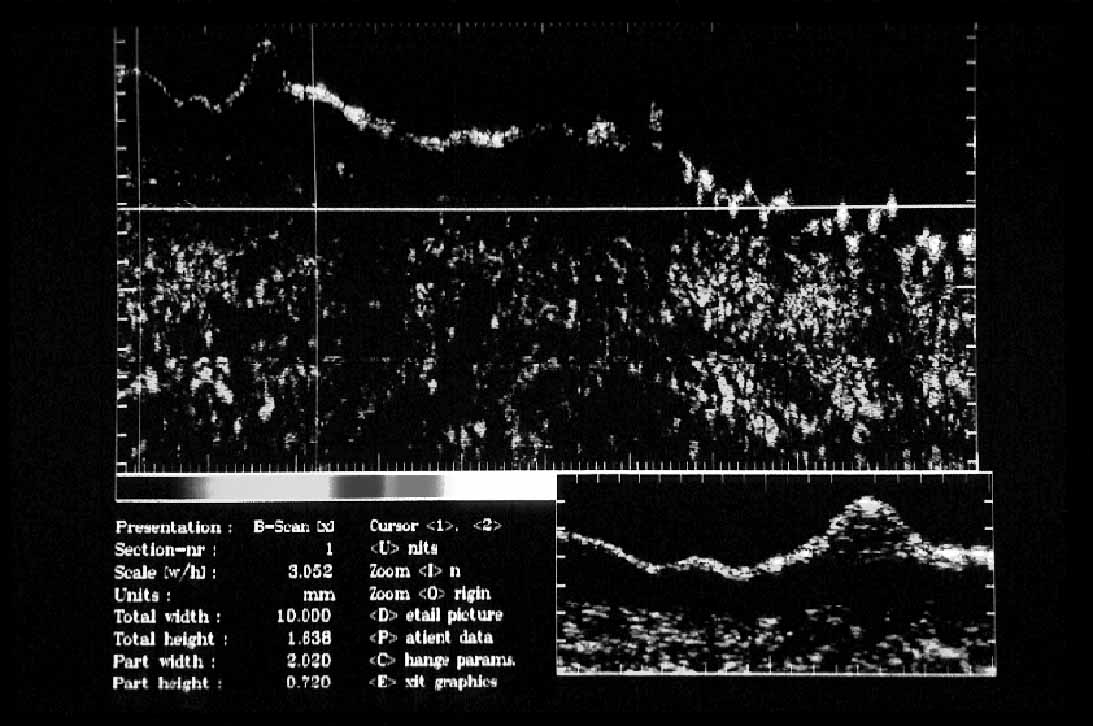New Technology Poster Session
| INABIS '98 Home Page | Your Session | Symposia & Poster Sessions | Plenary Sessions | Exhibitors' Foyer | Personal Itinerary | New Search |
Introduction
Clinically, the severity of the scabies disease ranges from a mild rash to a severe granulomatous manifestation.
In the mild form of scabies the intraepidermal burrows are gray or skin-colored ridges, 0.5 to 1.0 cm in length, either linear or serpiginous with minute vesicles or papules at the end of the tunnel. In ligth-skinned individuals, burrows have a whitish color with occasional dark specks (due to fecal scybala). The blind end of a burrow where mite resides appears as a minute elevation with tiny halo of erythema or as a vesicle.
The burrows show a specific distribution: they are specially located in hairless intertriginous regions where the stratum corneum is soft because the burrows lie within the stratum corneum.
We were especially interested in visualizing these burrows in the horny layer caused by scabies of moderate severity.
For this purpose we need an ultrasound transducer with a significant higher axial and lateral resolution than in the commercially available 20 MHz machines.
We used a 100 MHz transducer for this study.
Materials and Methods
100 MHz-Sonography
The 100 MHz ultrasound imaging unit consists of an applicator with the transducer, a transient recorder, a control unit and a computer.
The 100 MHz transducer has an axial resolution of 9 Ám and a lateral resolution of 27 Ám.
Applicator
Water is used as coupling medium. After placing the applicator on the skin, the plexiglas chamber is filled with water.
Three stepper motors are housed in the applicator which enable a precise movement of the transducer in all three axes.
Study design
We studied scabies eruptions in 10 patients at different locations.The severity of the disease ranged from a mild expression to a severe granulomatous manifestation.
Results
Intracorneal burrows were well visualized sonographically, even in patients with a mild form of scabies.
It was possible to determine the burrow diameter using sonometry.
Figure 1 shows a sonogram of a mild rash of scabies disease.
 Figure 1
Figure 1
One can see the burrows under a thin layer of stratum corneum.
The diameter of the burrows were 0.1 mm to 0.2 mm.
One can see also a higher echodensity in the burrow, especially in the enlargement. We think that this represents the fecal scybala, because an inflammation would be echopoor.
The echopoor band under the skin entry echo represents the epidermis, the papillary dermis and actinic elastosis in the upper dermis. The patient was over 70 years old.
Figure 2 shows a sonogram of a granulomatous rash of scabies disease.
 Figure 2
Figure 2
In patients with granulomatous scabies, sonographic examination revealed areas of relatively low echogenicity caused by the accompanying inflammatory infiltrate. In this case, the burrow diameter cannot be determined exactly. In the sonograms the infiltrate occurs echopoor.
The dimensions of the sonograms of the figures 1 and 2 are the same (10 mm x 1,6 mm).
Discussion and Conclusion
Using 100 MHz sonography it is possible to visualize and quantify changes in the horny layer in vivo.
During our experiments, we even succeeded in visualizing small intracorneal burrows which cannot be made visible in vivo by other means.
Furthermore, it was possible to determine the degree of severity and the depth of the scabies infection directly on the sonograms.
We conclude, that the 100 MHz sonography is well suited to evaluate diseases located in the stratum corneum.
| Discussion Board | Previous Page | Your Poster Session |